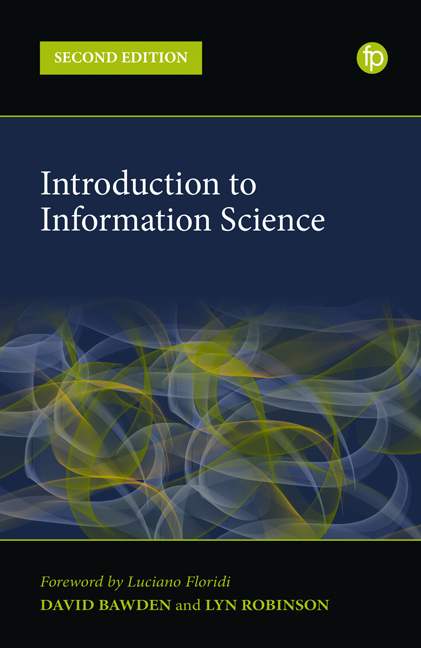Book contents
- Frontmatter
- Contents
- Figures
- Preface
- Foreword – Curators of Semantic Capital
- List of Acronyms
- 1 The Information Science Discipline
- 2 History of Information: the Story of Documents
- 3 Philosophies of Information
- 4 Paradigms, Turns and Theories in the Information Sciences
- 5 Information
- 6 Documents and Documentation
- 7 Domain Analysis
- 8 Information Organisation
- 9 Digital Technologies and Data Systems
- 10 Information Systems
- 11 Informetrics
- 12 Information Behaviour
- 13 Communicating Information: Changing Contexts
- 14 Information Management and Policy
- 15 Information Law and Ethics
- 16 Information Society
- 17 Digital (Onlife) Literacies
- 18 Research in the Information Sciences
- 19 The Future of the Information Sciences
- Additional Resources
- Index
13 - Communicating Information: Changing Contexts
Published online by Cambridge University Press: 21 April 2022
- Frontmatter
- Contents
- Figures
- Preface
- Foreword – Curators of Semantic Capital
- List of Acronyms
- 1 The Information Science Discipline
- 2 History of Information: the Story of Documents
- 3 Philosophies of Information
- 4 Paradigms, Turns and Theories in the Information Sciences
- 5 Information
- 6 Documents and Documentation
- 7 Domain Analysis
- 8 Information Organisation
- 9 Digital Technologies and Data Systems
- 10 Information Systems
- 11 Informetrics
- 12 Information Behaviour
- 13 Communicating Information: Changing Contexts
- 14 Information Management and Policy
- 15 Information Law and Ethics
- 16 Information Society
- 17 Digital (Onlife) Literacies
- 18 Research in the Information Sciences
- 19 The Future of the Information Sciences
- Additional Resources
- Index
Summary
For millennia libraries have acquired resources, organized them, preserved them, and made them accessible (or not) to patrons. But the forms of those resources have changed – from scrolls and codices; to LPs and LaserDiscs; to ebooks, electronic databases and open data refs. Libraries have had to at least comprehend, if not become a key node within, evolving systems of media production and distribution.
Shannon Mattern (2014, 1–2)We are all patrons of the Library of Babel now, and we are the librarians too.
James Gleick (2011, 426)Introduction
In this chapter we will consider some of the changes which have occurred, and are still occurring, in the way in which recorded information is communicated, largely as a result of digital technologies but also because of associated economic and sociocultural factors. This amounts to a consideration of the changing infrastructure of the infosphere. It has a wide scope, including publishing, data curation, news media, collection and memory institutions including libraries and archives, and social media. These will mainly be covered in outline, with references to other sources for more detail. The chapter is divided into three sections. The first deals with information chains and lifecycles, simple models which help to understand changes in the communication of information; the second deals with the communication of knowledge, through publishing in the broadest sense; and the third with information places and spaces, which act as nodes for the communication and sharing of information.
Information chains and lifecycles
The idea of a communication chain, or information chain, or information lifecycle of recorded information is fundamental for the information sciences, and it is also commonly invoked in explanations of information and digital literacies. Such a chain describes the processes of documentation from creation, through dissemination, organisation, storage and use to disposal. They have been applied to information and data, and to journal articles, books, archival records and other forms of document. Communicating information typically falls within ‘dissemination’ or similar steps, but is obviously dependent upon other stages.
- Type
- Chapter
- Information
- Introduction to Information Science , pp. 249 - 266Publisher: FacetPrint publication year: 2022



